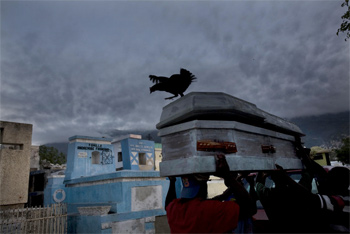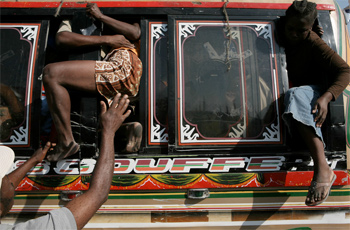Damon Winter and Shaul Schwarz are veteran photojournalists, and have seen more death and misery in foreign lands than most professional soldiers and aid workers would see in 10 lifetimes. But they were both unprepared for the catastrophe they found in Haiti in early January.
On Tuesday, Jan. 12, a few minutes before 5 p.m., a shallow 7.0 earthquake hit southern Haiti about 16 miles southwest of the capital, Port-au-Prince. It destroyed residential homes, the presidential palace, hospitals, schools, the port and damaged the airport. The number of dead is still being calculated but estimates stand at over 150,000 souls.

© Shaul Schwarz Reportage/Getty Images for Time
PORT-AU-PRINCE, HAITI - Jan. 15, 2010: Men carry a coffin for burial in the overflowing cemetery of Port-au-Prince.
According to Damon Winter, a
New York Times photographer who arrived just before nightfall on the day after the earthquake, "If you wander around anywhere, there's destruction. Pretty much every pile of rubble that you see – whether it looks like it or not – has people buried underneath. You have to be so careful. I was just stepping up to a pile of rubble to get a shot and I looked down and this woman's head was right there among the broken pieces of the building.
"It's overwhelming. The thing is: it's just everywhere. Everywhere you turn." On the road into the city he saw more dead bodies lying on the road than he had ever seen in his life.
And Damon has seen a lot in his career, first as a Los Angeles Times photographer, then on the staff of The New York Times in 2007. He has covered stories in Afghanistan, Israel, Vietnam, Cuba, Russia and India. In 2009 he won the Pulitzer Prize for feature photography for his images from the Obama campaign.
He is still trying to get his head around what he witnessed in those first days in Haiti. In the New York Times online "Lens" blog, Damon was quoted in an interview from Haiti.
"There was one thing that didn't really make pictures. It was my first night here last night. We were staying at a hotel on the edge of a pretty heavily damaged neighborhood and at night, you could hear people singing. People are out on the street at night. It's really hard to photograph because there's no electricity. It's pitch black. But all night you could hear them singing prayers. It's pretty amazing the ways that people are dealing with this tragedy. It says a lot about the Haitian character. They are an amazing people."
Talking about the challenges he faced as a photographer, he said, "It's really an amazing thing to be walking around in something like that [devastation and death] and have to worry about the logistics of taking a picture – how to compose and make sure your exposures are right – when you're looking at such a tragic scene. It's a bit overwhelming at times. It's really horrific."
In his images, Damon often seems to be working within the crush of people. Arms reach into the frame towards an injured victim of the earthquake. People press into a bus for the last small bit of space to escape the city, and the desperate face of a person is squashed against the chests and shoulders of others in a crowd.
Damon's only regret is never seeing Port-au-Prince before the quake. Speaking to other photographers he has heard many stories about the special relationship they have with Haiti and the people. He understands that better every day. The word "graceful" came up several times as he described the Haitians. He admires their strength, beauty and gracefulness in the face of complete catastrophe and great sadness.

© Damon Winter / The New York Times
PORT-AU-PRINCE, HAITI - Jan. 18, 2010: People crammed into buses bound for Les Cayes, a city in the southeastern part of Haiti, from the main bus station in downtown Port-au-Prince. Residents filled bus after bus headed out of the city as conditions after the earthquake continued to deteriorate.
Unlike Damon Winter, Reportage/Getty Images photographer Shaul Schwarz is experienced in covering Haiti. In 2004 he received two World Press Photo Awards for his work in the conflicts of the country. He holds a fascination for the island, and has recorded it both at war and at peace. In 2006 his pictures won the prestigious Visa d'Or at the Perpignan festival, and last year was awarded the Robert Capa Gold Medal of the Overseas Press Club.
Within hours of the catastrophe, Shaul had made his way into the Dominican Republic on assignment for Time magazine and CNN. He and other photographers were able to hitch a ride in the back of a family pickup truck for the drive into Port-au-Prince.
It just so happened that the family driving the truck owned the Montana Hotel. The group arrived at the hotel as darkness was falling. The hotel had collapsed and the owners didn't know how many people were trapped inside and how many might still be alive. It was a shocking scene to contemplate.
The family drove the photographers to a hotel that was only partially collapsed. The truck had to stop some distance from the hotel because area residents had come hoping to receive some help. The ground was carpeted with the injured and the dead. Stepping over and around bodies to get to the entrance, the magnitude of the situation really hit home for Shaul. He opted to sleep inside, knowing the risks. Throughout the night he heard people crying. Every now and then the grief and cries would become intense and he'd realize that someone else had died. He laid in the dark overwhelmed with helplessness – and the photographic job hadn't even begun.
The next morning he hitched a ride on another truck. The passing scenes were increasingly horrible. Near the city center he saw two men with a wooden wheelbarrow containing the bodies of dead children and he jumped off the truck to investigate. The men took him to the hard-hit Fort National neighborhood.
On this morning after the quake people walked around in shock. Bodies were everywhere, some in piles and most mixed into the rubble. Shaul thought, "How do they clean up? Where do they start?" By then he'd heard about the magnitude of the quake and just looking at one street among hundreds, it was hard to fathom the scale.
After only two hours he felt he should transmit the images made so far. Charging batteries was no problem with the hotel's generators but the Internet was a problem. He had left so quickly that he didn't have time to go to Getty Images and pick up a Sat phone. He met a man who ran Access Haiti and went to the offices to transmit. Since the wireless network was accessible, if it was too crowded to get inside he could sit on the ground outside and still transmit.
Shaul spoke about his images and photographing in a crisis of historic proportions. He'd been to Haiti twice previously and knew that is was an "explosively colorful place." In good times he used "layering" of the color in an image. That self-training paid off at moments in Haiti when it was impossible to think about the resulting image. Regarding the blue/black picture of the coffin being carried above men's heads against an angry, mottled sky, he says he remembers noticing the sky first, then seeing the coffin with a rooster on top. The rooster was unexpected and completely out of place. The men were moving towards the last light of day so the rooster was in silhouette and Shaul pressed the shutter button and moved on.
He was deeply shocked by everything he encountered but strived to stay in the moment, to stay sharp, to remember: "I'm here to take a picture." In this, the camera becomes a shield, a protective layer between terrible death and the photographer. He observed that the job he was there to do, as well as the camera, work jointly to form a shield. As he observed, "I can't grieve at every funeral." Work had to be done. The situation is "a dance between how much you are touched” by the scene and how well you do your job: "This is your time – this is what you trained for." He wants to be part of a "positive chain reaction," making "compelling images" and having "the public react."
He believes that it is the magnitude of work by many different people that gets the story across, especially in the Internet age.
Of course, Damon Winter and Shaul Schwarz are only two of the many photojournalists who rushed to Haiti along with thousands of rescue workers, doctors and volunteers who are giving their best to somehow help this devastated island. We are proud to present their work in this issue.
Dirck Halstead was Time magazine's Senior White House Photographer for 29 years. He now is the Publisher and Editor of The Digital Journalist, the monthly online magazine for visual journalism, and a Senior Fellow at the Center For American History at the University of Texas in Austin. His new book, MOMENTS IN TIME, published by Harry N. Abrams, is in bookstores, and available from Amazon.com.